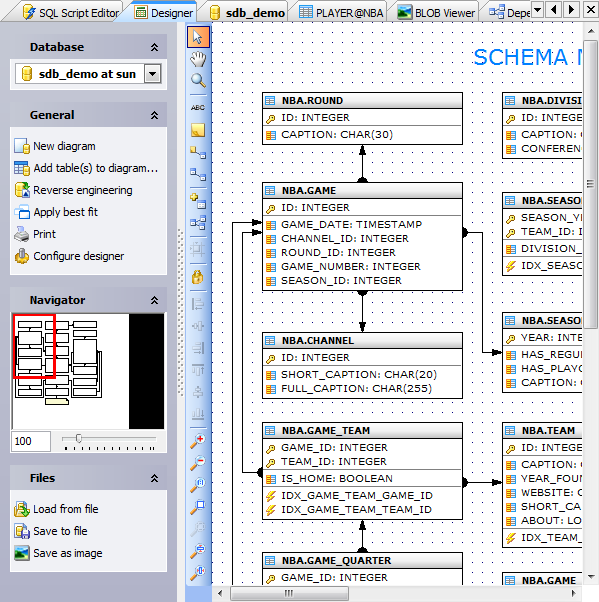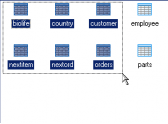![]()
![]()
![]() Partners
Partners
![]() Testimonials
Testimonials
Simon Pills: "Someone finally invented an intuitively used and easily customized PostgreSQL database administration tool! Keep up the good work. I will be in touch. I am able to do this horrendous work because your software enabled me to create a new database with all necessary objects in several minutes! I am sure that I have found what I really need".
Daryl Joubert: "I am evaluating your PostgreSQL Maestro product for purchase by my company and thus far I am very impressed! I really like the easy, intuitive and productive user interface and feature set. I am also evaluating a number of other products for PostgreSQL database design and maintenence but thus far SQLMaestro stands head and shoulders above the rest".
More
Add your opinion
![]() Customers
Customers
PostgreSQL Maestro online Help
Schema Designer
![]()
Schema Designer allows you to create physical Entity Relationship Diagram that will represent objects in your PostgreSQL database. A diagram represents the tables of your database and the relationships between them. The tool is intended for reverse engineering and database modification in an easy and powerful way. It helps you to simplify database maintenance.
A diagram of your database can help you define operational aspects of your application logic that you might otherwise overlook. Also, a well-defined data diagram that accurately represents your tasks can be helpful in orienting employees to goals and operations. The data diagram can also serve as an invaluable communications tool for both internal and external constituents.

Below you can find answers for the following questions:
See also: Designer Navigation bar, Schema Designer Toolbox.
Adding a table
You can add an existing PostgreSQL table to the diagram using popup menu in the working area, or with the corresponding link on the Navigation bar.
To create a new table, use the appropriate item of the popup menu in the working area. The table will be created in the current database.
Tables also may be dragged on the diagram from Explorer and the similar to Explorer tools like Object Manager and Object Browser.
Moreover, Designer provides you with a possibility to represent all the tables and relationships existing in the database automatically (the Reverse engineering link of the Navigation bar). At that the database contents will be represented on a diagram in the most compact and vivid manner.
All the diagram objects are available for editing. Just double click the object (table or relationship) to view/edit its properties within the corresponding editor.
Adding a relationship between tables
At adding to a diagram tables that reference on each other, the relationships between tables are represented automatically. The Schema Designer tool also allows you to add new foreign keys to the diagram tables. Thereto you can do the following.
Select a table (child table)
| • | Specify there properties of the relationship been created. |
Moreover you can add a reference graphically:
| • | Choose the Create relation tool on the Toolbox. Your mouse cursor will change its appearance. |
| • | Then click on the table (child table) that will have foreign key and then click on the second table (parent table) whose primary key will be referred by the new foreign key. |
With the Create new… item of the popup menu you can also add a new field, an index, a trigger, etc. to the selected table. For more information about object properties see: Field Editor, Index Editor, Create Trigger Wizard.
Deleting of the diagram objects
To hide a table (several tables) or a relationship between tables, select the objects and click Remove selection link of the popup menu or Navigation bar. You can also use the Del key for this purpose.
It's also possible to physically delete a table/foreign key from the database: just select the object to delete and use the appropriate item of the popup menu.
Editing of a diagram appearance
Movement of a table/several tables along the diagram is realized with dragging or pressing Ctrl+arrows. You can use Shift+arrows to change width/height of table/several tables representation.
Designer also allows you to edit shape of the line representing foreign key relations/logical relations. In order to break the line you should
| • | Select the relationship. |
| • | Press Ctrl and click on the necessary line section to create a new node. |
| • | Position the node by dragging. |
You can also delete a node on the line. Thereto
| • | Select the relationship. |
| • | Press Alt and click the node to delete. In that case the near nodes will be united by a straight line. |
Christmas Sale
 |
| SQL Maestro Group wish you a Merry Christmas! |
| We're happy to grant you a 20% discount for all our products and bundles till December 31! |
![]() Company news
Company news![]()
Dec 15, 2021
New version comes with PostgreSQL 14 compatibility, introduces support for new multirange data types, SSL connections, optimized partition management and some other enhancements.
Oct 14, 2020
All products of our PostgreSQL family come now with PostgreSQL 13 compatibility.
Oct 18, 2019
New version comes with PostgreSQL 12 compatibility, introduces support for stored generated columns, using of planner support functions in functions and some other enhancements.
![]() Resources
Resources
This article discloses the ways of role management provided by PostgreSQL Maestro. Learn how to create, edit, grant and carry out other manipulations with roles using our product.
![]() Feature of the day
Feature of the day

PostgreSQL Maestro enables you to perform the same operation upon several objects at a time.

Create Composite Type Wizard allows you to create a new PostgreSQL composite type in a few mouse clicks.
Source: https://www.sqlmaestro.com/products/postgresql/maestro/help/06_08_00_database_designer/
Posted by: hiediniemczyke0193139.blogspot.com